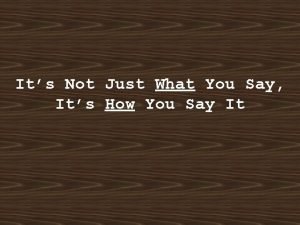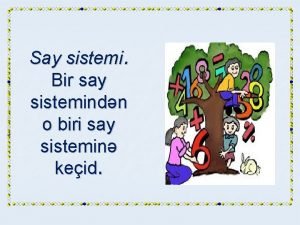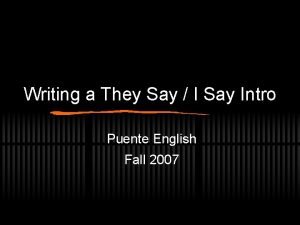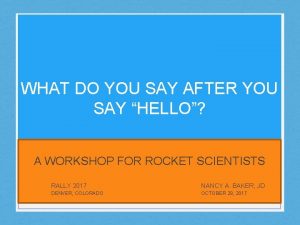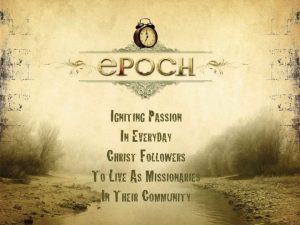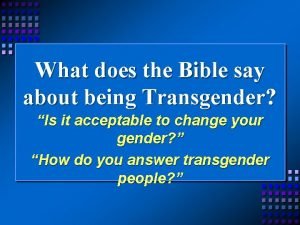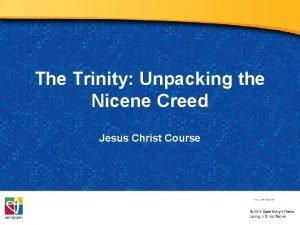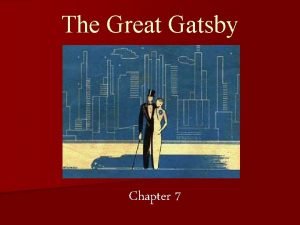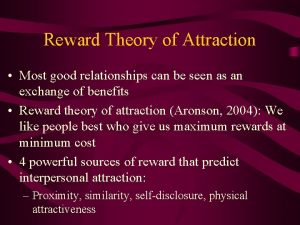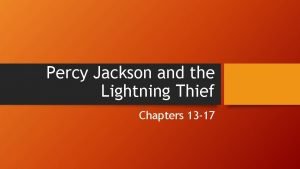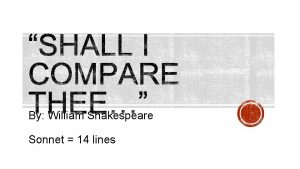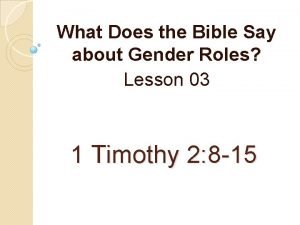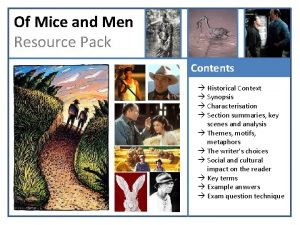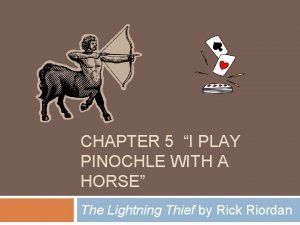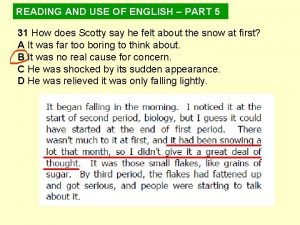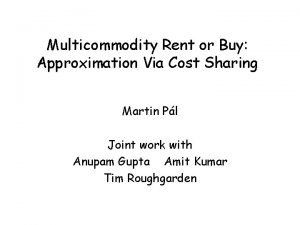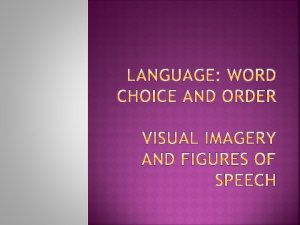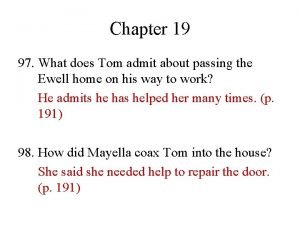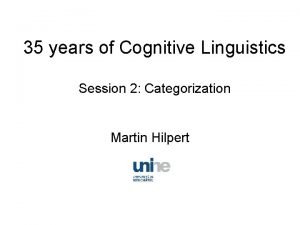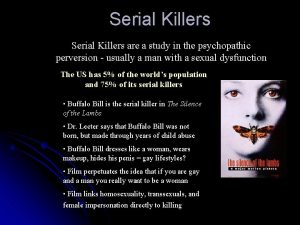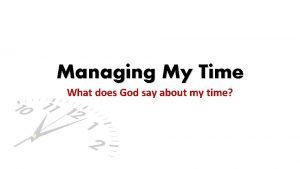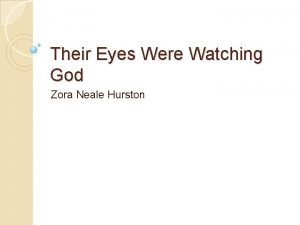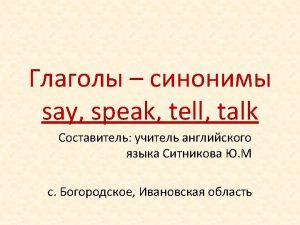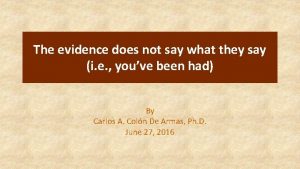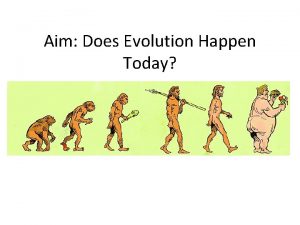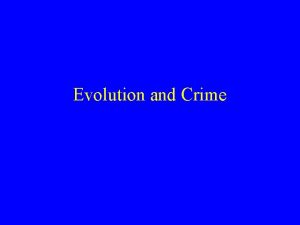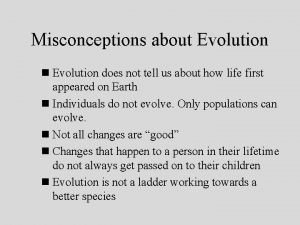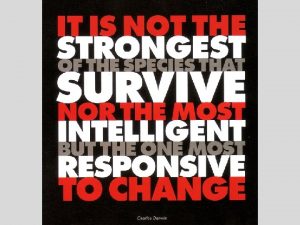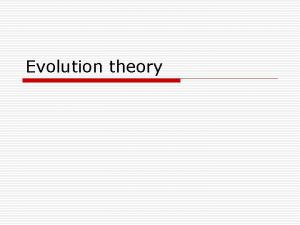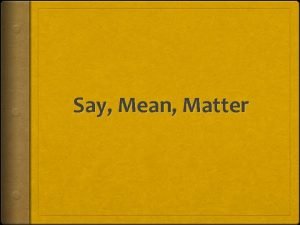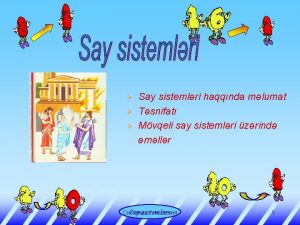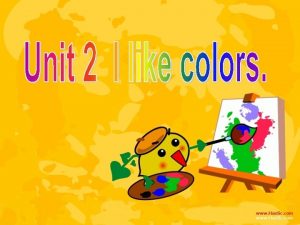Evolution What evolution does NOT say Does NOT


































































- Slides: 66

Evolution

What evolution does NOT say: • Does NOT say humans came from apes. • Does NOT say how life began on Earth. • Does NOT say one cannot have “faith”

What evolution IS: • Best theory we have right now to explain the variety of life on Earth. • Is supported by an enormous amount of evidence (that you must know for the test). • Is open to being changed or discredited if more scientific data is discovered. • Is a controversial topic, even today.

Evolution • The process by which species change over time. • Evolution Video

Charles Darwin

“Descent with Modification” • Charles Darwin: 1809 -1882 • Wrote the book On the Origin of Species which gave us theory of evolution through Natural Selection.

The evolution song: • Evolution Song

NATURAL SELECTION • “THE SINGLE MOST IMPORTANT FACTOR IN THEORY OF EVOLUTION”

How Evolution works through Natural Selection • Natural Selection is the “vehicle” that “drives” Evolution. • Natural Selection and Evolution • With your partner, come up with an analogy to show evolution and natural selection are related:

The Four Parts of Natural Selection • Adaptation – The traits that improve survival and reproduction become more common. • Overproduction – Each population is capable of producing more offspring than can survive. This create competition. • Variation (due to genetics) – All offspring are different. • Selection – The offspring best suited to the environment survive and pass those traits on to their offspring.

A question to ponder…. • With your partner, discuss how a giraffe’s neck got to be so long. Be able to explain the “how” part in some detail.

Natural Selection: 1)Adaptations • Definition: A trait that makes an organism better suited to its environment • Adaptations take time and occur over many generations

So how DID their necks get so long…. • Class discussion…. share your thoughts. • the answer. .

Quick Formative Assessment… • How did the clam in the video develop these adaptation despite being blind? – Note: Show first 2: 16 of video and stop it before the question. Answer follows 2: 16. • Natural Fish Lure | Lampsilis Mussel and Bass

Other Adaptations • Discuss with your partner what adaptations you see in this picture.

On your own, think about what adaptations are here? • Clown fish and sea anemone.

What about adaptations here? • Penguin

Natural Selection: 2)Overproduction • Organisms produce more offspring than can possibly survive. • This creates competition where the best fit for their environment will survive. • The competition is due to the fact that environmental resources are limited. • With your partner, come up w/3 examples of competition in nature. .

Overproduction/Competition Video • Quick and simple example • Quick Lecture on Competition

Natural Selection: 3) Variation • The idea that all members of a species are slightly different from one another and this difference is in their genes. • This variation makes it more likely that at least some will survive a sudden catastrophic change or even a series of small changes. Over time this can lead to change in species…aka. . . evolution. • Think of one example of this in nature.

Genetic Variation • Mechanisms of Variety • Part 2 • Result of variety. . .

Natural Selection: Selection • “Survival of Fittest” • Those organisms best fit to their environment will survive (be “naturally selected”) and pass those traits to their offspring. • The traits are passed on via reproduction. • Those not fit don’t reproduce and their traits and genes for those traits aren’t passed.

Independent Practice • Get a piece of paper and answer the following questions: • Page 379: 1 and 4 • Page 385: 1, 2, 3, 4, 5 • Page 389: 1, 2, 3 • YOU MUST WRITE OUT THE QUESTION AND THE ANSWER!

Evidence for Evolution • • 1) The Fossil Record 2) Embryology 3) Comparative Anatomy 4) Molecular and Biochemistry • With your partner, discuss what you think each of these may be.

Evidence for Evolution: Overview • OVERVIEW OF EVIDENCE FOR EVOLUTION video….

1) THE FOSSIL RECORD • Fossils are the remains of organisms or the imprint of organisms in rock. • Fossils are usually found in sedimentary rocks. • Fossils can be dated by the rocks they are found in or by Carbon Dating parts of the organism.

Evolution Video Series These are not meant to be shown all at this time. Part 1: Overview of Evolution, begin fossil Part 2: Continuation of fossil record Part 3: Geologic time and Speciation Part 4: Rate…/Embryology/Nucleotides Part 5: Using Genetic differences to show relatedness • Part 6: Psuedo genes/Retrovirus lineage • • •

The Fossil Record (continued) • Video clip

Law of Superposition (Laundry Law) • Law of Superposition Video • With your partner, explain how this could be like a laundry hamper. Be ready to report out to the class.

Absolute Dating • Getting a near exact date of a rock or fossil.

Radiometric Dating • Some rocks are radioactive when created. These rocks become stable at a constant rate, known as half-life. • For example, Uranium 238 (U-238) has a half life of 4. 5 billion years. In that time, half of the sample would be radioactive U-238 and the other half would be U-234 (which is nonradioactive called “stable”).

Radiometric Dating continued… • By looking at the percentage of U-238 and U-234, one can determine how old the sample is…and infer how hold the fossils are around it, in it, or in the same layer. • Example: Scientists find a rock sample that is 75% radioactive U-238 and 25% stable U-234. • The sample would be approximately 2. 25 billion years old!

Carbon Dating

Carbon Dating of Fossils • Carbon 14 is a radioactive form of Carbon that occurs naturally. • When an organism dies the amount of Carbon 14 in the bones slowly decreases. • The “half-life” of Carbon is 6, 000 years. (Approximately every 6000 years half of the Carbon 14 is converted to N-14. ) • How old would an organism be if it was found to have 25% Carbon 14 and 75% N-14? Explain

Phylogenetic Tree • Way to show relatedness of species by indicating common ancestors. • Can show present day organisms as well as those that have gone extinct. • Video: Phylogenetic Tree

Example of a phylogenetic tree:

2) EMBRYOLOGY • Scientists compare how organisms develop from embryos (fertilized eggs) until they become adults. • By comparing the changes the embryos go through it can be determined how closely organisms are related. This implies a common ancestor. • Example: All vertebrates have a tail and gill pouches at some point in their development


3) COMPARATIVE ANATOMY • The anatomy of different organisms are compared to see relationships • Homologous structures- structures that similar in two or more species Homologous Video • Example: Arm bones of many vertebrates have the same arrangement. (See book pg 384) • Vestigial Structures- structures that are “left over” from the past and have no clear function. Example appendix Vestigial Structure Video


Comparative anatomy (cont…) • Both shared structures and vestigial structures infer a common ancestor. • Vestigial structures show species have change from a time when they need them. • Shared structures show we came from the same genetic line (passed down the line)

4)MOLECULAR & BIOCHEMISTRY • ***THE BEST EVIDENCE FOR EVOLUTION • Comparing the DNA and proteins of organisms for the number of differences • The differences are usually caused by some type of mutation • The fewer the number of differences the closer the relation between the organisms • (See slide #27, Part 5)

Molecular & Biochemistry (cont…) • This area also implies that organisms share common ancestors. In fact, all life we’ve ever know shares the same DNA make-up (remember A-T, G-C? It’s in all living things)

RATE OF EVOLUTION • Gradualism-Slow consistent change over a long period of time • Punctuated Equilibrium-Long periods of little or no change, followed by a short period with a lot of change. • ***Most likely a combination of both.

GENETIC DRIFT • When a random (not natural selection) event changes the make-up of the alleles frequency in a population. • Example: a group of ducks in a lake are killed by a fiery airplane crash. Those that survive were just lucky. “Stuff Happens”. • Genetic Drift video

SPECIATION • Species-Two organisms that can mate and create offspring that can also reproduce. • Speciation video • Mr. Anderson…. • Speciation and Extinction 1 to 2, 1 to 0

“Non-on-the-Test” Evidence: Biogeography • Different continents with similar biomes have similar organisms. • Examples Rhea, Ostrich and Emu • This suggests that similar environments shape the evolution of organisms in similar ways.

Ostrich Emu Rhea


Beyond Darwinian Theory Forces that change allele frequencies Microevolution

Allele Frequency • Allele Frequency-The percentage of dominant, recessive, co-dominant, or incompletely dominant alleles that appear in a population • The number of each allele does not change unless an evolutionary force is acting on it. it

Evolutionary Forces That Change Allele Frequency • Each of the following cause the allele frequency to change • Mutation • Gene flow (migration) • Nonrandom mating (mate choice) • Genetic drift • Natural selection

Mutation • One allele turns into another by a mutation in the genetic code • Does not occur very often and are usually lethal • Occurs 1 -10 times per 100, 000 cell divisions

Mutations • Changes that happen in one generation • May occur by a change in either the egg or sperm of a parent • May be caused by a virus, toxic chemical, drug, bacteria or radiation • May be caused by an error in cell division


Gene Flow (Migration) • The movement of genes (alleles) from one population to the next • Migration – Immigrants - bring in new alleles to a population – Emigrants – take alleles out of a population

Nonrandom Mating (Mate Choice) • When we mate with individuals like ourselves we change the allele frequency to become more …… • Homozygous • A mate is usually chosen based on certain traits

Genetic Drift • Small populations and/or isolation • In small populations if a catastrophic event occurs one of the allele frequencies could be reduced • If individuals are “trapped” on an island, one of the allele frequencies could be reduced

Divergent Evolution • Divergent Evolution - is the process of two or more related species become more and more dissimilar.

More Divergent Evolution

Convergent Evolution • Convergent Evolution - unrelated species become more and more similar as they adapt to the same environment

Convergent Evolution

Coevolution • Coevolution - the joint change of two or more species in close interaction. • Often predator and prey


Extinction and Extripation • Extinction: If all the members of a species is not longer found on Earth. • Extripation: All members of a species in a given geographic location are no longer in that area.

Dodo Bird
 It’s not just what you say, it’s how you say it.
It’s not just what you say, it’s how you say it. They say i say counter argument templates
They say i say counter argument templates Metacommentary definition and examples
Metacommentary definition and examples Gerald graff
Gerald graff They say i say essay format
They say i say essay format They say paragraph
They say paragraph They say i say paragraph examples
They say i say paragraph examples What are voice markers they say i say
What are voice markers they say i say They say i say the moves that matter
They say i say the moves that matter They say i say quotation sandwich
They say i say quotation sandwich Planting a naysayer in your text
Planting a naysayer in your text As he himself puts it the art of quoting summary
As he himself puts it the art of quoting summary Mövqesiz say sistemi
Mövqesiz say sistemi They say i say chapter 10
They say i say chapter 10 How do you say puente in english
How do you say puente in english Fire and ice diamante poem
Fire and ice diamante poem Some say the world will end in fire some say in ice
Some say the world will end in fire some say in ice What do you say after you say hello download
What do you say after you say hello download They say i say
They say i say Sudden and violent but brief; fitful; intermittent
Sudden and violent but brief; fitful; intermittent Say the color not the word
Say the color not the word Do not say there are four months
Do not say there are four months Being dyslexic
Being dyslexic What does the bible say about sex
What does the bible say about sex What does the bible say about transgender people
What does the bible say about transgender people What does the declaration of independence say
What does the declaration of independence say What is nasreen putting chocolate on
What is nasreen putting chocolate on Trinity in the nicene creed
Trinity in the nicene creed Great gatsby ch 7 summary
Great gatsby ch 7 summary In scene iv, what does capulet tell paris
In scene iv, what does capulet tell paris Reward theory of interpersonal attraction
Reward theory of interpersonal attraction Bible verses against polygamy
Bible verses against polygamy Draw a pig exercise
Draw a pig exercise Annabeth seems worried
Annabeth seems worried Frankenstein ch 4 summary
Frankenstein ch 4 summary Definition of le chatelier's principle
Definition of le chatelier's principle What do the townspeople believe janie has done to joe?
What do the townspeople believe janie has done to joe? William shakespeare sonnet
William shakespeare sonnet What does the bible say about questioning someone's faith
What does the bible say about questioning someone's faith What does the bible say about gender roles
What does the bible say about gender roles What does god say about dancing
What does god say about dancing What does jesus say about war and peace
What does jesus say about war and peace Does congress have the power to have no mail on saturdays
Does congress have the power to have no mail on saturdays What does it say?
What does it say? Where is andy going ans
Where is andy going ans What does crooks say to lennie that upsets him
What does crooks say to lennie that upsets him What made oedipus go to the oracle when he was young?
What made oedipus go to the oracle when he was young? Man's sinful nature
Man's sinful nature Why does grover say he retrieved the minotaur horn?
Why does grover say he retrieved the minotaur horn? What does it say
What does it say Promethesius
Promethesius Reading and use of english part 5
Reading and use of english part 5 What does this picture say
What does this picture say What is a diction in a poem
What is a diction in a poem How do zimbabwe celebrate christmas
How do zimbabwe celebrate christmas What does that say
What does that say What does this say
What does this say Pay attention what your teacher says
Pay attention what your teacher says What does this say?
What does this say? Matthew 5:8 meaning
Matthew 5:8 meaning What does this say
What does this say What kind of person is malcolm in macbeth
What kind of person is malcolm in macbeth Bedside shift reports what does the evidence say
Bedside shift reports what does the evidence say What i learnt from the chapter a gift of chappals
What i learnt from the chapter a gift of chappals Powder keg of europe ww1
Powder keg of europe ww1 What does it say
What does it say What is janie and joe's first impression of the town
What is janie and joe's first impression of the town
